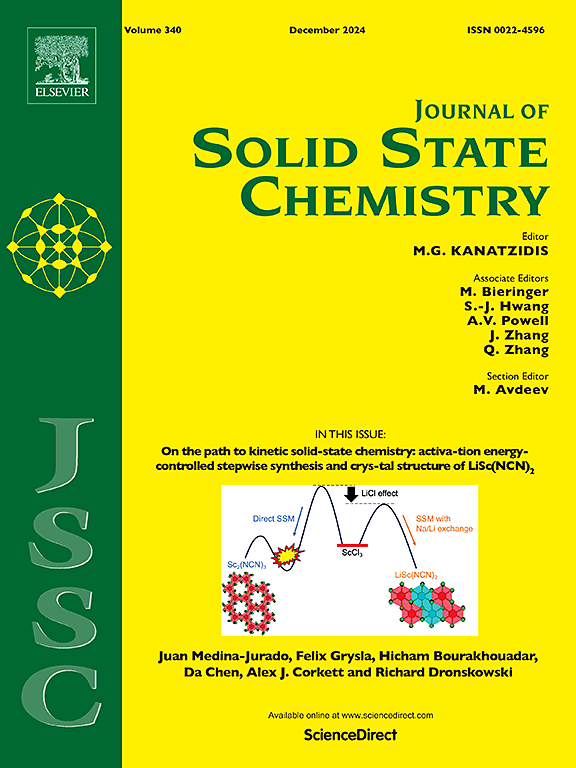铁铝柱状磷灰石对水溶液中 Sb(Ⅲ)的吸附的合成、表征和研究
IF 3.5
3区 化学
Q2 CHEMISTRY, INORGANIC & NUCLEAR
引用次数: 0
摘要
本研究以磷灰石为基体,FeCl3 和 AlCl3 为金属源,通过共聚法制备了一种简单、环保且廉价的水溶液中锑(III)吸附剂。通过多种表征方法分析了铁铝柱状阿塔蓬石的形态和结构。研究了铁铝柱状阿塔蓬石的制备条件和吸附 Sb(III)的影响因素。吸附过程符合 Langmuir 等温模型和伪秒阶动力学模型,热力学考察表明吸附过程为自发内热吸附过程。X 射线光电子能谱分析和 Zeta 电位分析表明,Sb(III) 首先被吸附剂静电吸附,部分 Sb(III) 被 Fe(III) 氧化成 Sb(V),然后锑与铁和铝的氢氧化物络合形成表面络合物。此外,还有少量锑通过颗粒内扩散迁移到内部微孔中,并与羟基发生反应。在所选条件下,大多数共存成分对锑(III)的吸附没有影响,PO43-、AsO33-、C6H8O7 和 H2C2O4 的影响可以忽略不计。然而,无干扰的吸附容量超过 90%,这表明该材料对 Sb(III)的吸附具有很强的选择性。解吸实验结果表明,当盐酸浓度增加时,吸附产物具有相当程度的解吸能力。由于受污染水环境的实际酸度明显低于解吸实验酸度,因此可以得出结论,吸附产物在整个受污染水环境中更加稳定。总之,铁铝柱状阿帕石在去除 Sb(III)方面具有很大的应用潜力。本文章由计算机程序翻译,如有差异,请以英文原文为准。

Synthesis, characterization and study of Sb(Ⅲ) adsorption from aqueous solution by iron-aluminum pillared attapulgite
In this study, a simple, environmentally friendly and inexpensive adsorbent for Sb(III) in aqueous solution was prepared by the copolymerization method using attapulgite as the matrix, FeCl3 and AlCl3 as the metal sources. The morphology and structure of iron-aluminum pillared attapulgite were analyzed through various characterization methods. The conditions and influencing factors of iron-aluminum pillared attapulgite preparation and Sb(III) adsorption were studied. The saturated adsorption capacity of Sb(III) could reach 60.44 mg·g−1 for 180 min at pH 7 and 298 K. The adsorption process is conformed to Langmuir isothermal model and pseudo-second-order kinetic model, and the thermodynamic investigation suggested a spontaneous and endothermic adsorption process. It was revealed by X-ray photoelectron spectroscopy analysis and Zeta potential analysis that Sb(III) was first electrostatically adsorbed by the adsorbent, part of Sb(III) was oxidized to Sb(V) by Fe(III) and then antimony was complexed with iron and aluminum hydroxides to form surface complexes. In addition, a small amount of antimony migrated through intra-particle diffusion into the internal micropores and reacted with hydroxyl groups. Most coexisting components under the chosen conditions had no influence on Sb(III) adsorption, and PO43−, AsO33−, C6H8O7 and H2C2O4 had a negligible effect. However, the adsorption capacity of over 90 % without interference showed that the material has a strong selectivity for Sb(III) adsorption. The findings of the desorption experiment showed that the adsorption product has a considerable degree of desorption at increased hydrochloric acid concentrations. It may be concluded that the adsorption product is more stable in the overall polluted water environment since the actual acidity of the polluted water environment is significantly lower than the desorption experiment acidity. Overall, iron-aluminum pillared attapulgite has great potential for application in removing Sb(III).
求助全文
通过发布文献求助,成功后即可免费获取论文全文。
去求助
来源期刊

Journal of Solid State Chemistry
化学-无机化学与核化学
CiteScore
6.00
自引率
9.10%
发文量
848
审稿时长
25 days
期刊介绍:
Covering major developments in the field of solid state chemistry and related areas such as ceramics and amorphous materials, the Journal of Solid State Chemistry features studies of chemical, structural, thermodynamic, electronic, magnetic, and optical properties and processes in solids.
 求助内容:
求助内容: 应助结果提醒方式:
应助结果提醒方式:


